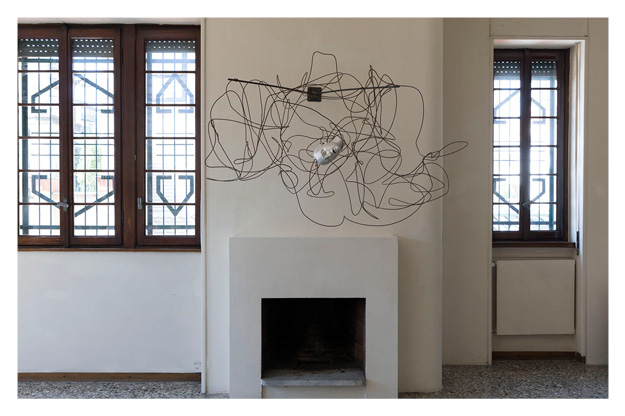To understand what this warning is about, we need only move to the Salon of Casa Testori. Three masters of contemporary Italian art are exhibiting here: Mimmo Paladino, Emilio Isgrò and Gianni Dessì. Paladino’s work is a sculpture created in 2013 and inspired by the troubled life-story of the great 16th century musician Gesualdo da Venosa. Like the twists of a serpent with neither head nor tail, a serpent from which we cannot free ourselves, a steel wire holds prisoner a head made of aluminium. This master, born in Paduli, considers himself first and foremost a painter, and for this reason says that “in my sculptures I have always thought of the artists who made use of this graphic architecture even in the past”. This inextricable knot holds captive the human icon, which Paladino nevertheless portrays with its irreducibile content of tension and beauty. The imagery already seen in Andrea Bianconi’s work undergoes here a dramatic and disturbing development. In his innumerable proclamations against the evil wrought by corruption upon people’s lives, Pope Francis – who has described this as a “social cancer” in his apostolic letter Evangelii Gaudium – has recourse to the metaphor of “ramification”: something that develops progressively and uncontrollably. Paladino’s work evokes this deleterious process.
Also exhibited in this room are four paintings from one of the most famous cycles by Emilio Isgrò: La costituzione cancellata. Rappresentazione di un crimine [The Constitution Cancelled: Portrayal of a Crime], from 2010. “I was pushed in this direction by the melancholy disappointment of an Italian who sees his country collapsing”, declared the artist when explaining the motive underlying this work. Cancellation is, in this case, an act of profound respect. The Constitution, Isgrò has said, “is a work of art, on a level with St. Francis’s Cantico and Dante’s Commedia. It is written in perfect Italian, simple, bureaucratic but without falling into gobbledygook. The fathers of the constitution were persons of the highest culture”. But the Constitution cancelled is also the “Portrayal of a Crime”, as the full title states. Isgrò makes use of cancellations to show how far too many people play games with the text of the constitution. These, in fact, are the surviving words that provide titles for the four works on display: “A handicapped indivisible, Secret associations are notprohibited, Those born in February are Senators as of right, Dated 27 December 1947. Respect combined with condemnation, veneration combined with bitterness: these are the sensations communicated by Isgrò’s work.
Gianni Dessì’s diptych is a very recent work. It consists of oil paintings on canvas, done in a sort of black on black. One of the works, A&E, refers to the event that symbolically represents the advent of corruption. The serpent appears as the great corruptor. The other work, Insieme [Together], has another human figure: to the left of the figure is a geometrical element which, cold and neutral, seems to spring like a trap.
At the centre of the room, Katja Noppes has a surprise for us. This is a simple Installation that sets in motion a process from which we cannot escape. Images of corruption, war and injustice, gathered from all latitudes over more than 25 years, are reflected in the mirror. We see only the reflection, and our own image mingles with them, as does that of the enchanted environment in which we find ourselves. Corruption affects us, therefore. We cannot get away from it and we cannot illude ourselves that we have nothing to do with what we see. There is no room for neutrality. Extrapersonal, peripersonal and personal spaces are superimposed.













